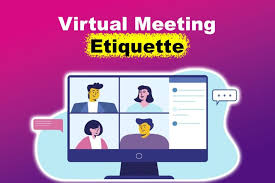The rise of remote work and virtual collaboration has made online meetings a regular part of professional and personal life. Whether it is a business conference, a virtual class, or a team brainstorming session, how participants conduct themselves can shape the success of the meeting. Poor etiquette can lead to distractions, wasted time, and misunderstandings, while good etiquette fosters productivity, respect, and effective communication. Understanding the principles of online meeting etiquette helps ensure that digital interactions remain as professional and impactful as in-person meetings.
Prepare Before the Meeting
Preparation is one of the most important aspects of online meeting etiquette. Coming unprepared not only wastes time but also reduces the quality of discussions.
Ways to prepare include:
- Reviewing the agenda in advance to understand discussion points
- Gathering necessary documents, presentations, or reports before joining
- Testing internet connection, microphone, and camera to avoid interruptions
- Familiarizing yourself with the meeting platform, such as Zoom, Microsoft Teams, or Google Meet
Being well-prepared ensures smoother participation and shows respect for the time of others.
Be Punctual
Timeliness is essential in online meetings. Logging in late not only disrupts ongoing conversations but also reflects poorly on professionalism.
To maintain punctuality:
- Join the meeting a few minutes early to settle in
- Check device settings ahead of time to avoid last-minute issues
- Respect the scheduled start and end times
Being punctual also helps meetings run more efficiently and demonstrates consideration for everyone involved.
Dress Appropriately
Even though online meetings happen in the comfort of home or other informal spaces, appearance still matters. Dressing appropriately helps set a professional tone and shows seriousness.
Tips for dressing:
- Choose clean and tidy clothing suitable for the meeting’s nature
- Avoid overly casual attire in formal settings
- Consider neutral or simple backgrounds that complement professional presence
Maintaining a professional appearance reinforces credibility and focus.
Use Proper Camera and Microphone Etiquette
The camera and microphone play a significant role in online communication. Using them responsibly improves interaction and reduces distractions.
Guidelines include:
- Keep the camera on when possible to show attentiveness
- Mute the microphone when not speaking to prevent background noise
- Position the camera at eye level for natural engagement
- Ensure good lighting so facial expressions are visible
This creates a more engaging and respectful meeting environment.
Minimize Distractions
Online meetings can easily be disrupted by background noise, multitasking, or constant notifications. Participants should create an environment that encourages full attention.
Ways to minimize distractions:
- Sit in a quiet space with limited interruptions
- Silence or turn off phone notifications during the meeting
- Avoid browsing, checking emails, or multitasking while discussions are ongoing
Focused attention not only helps absorb information but also shows respect for the speaker and fellow participants.
Practice Active Listening
Active listening ensures meaningful contributions and prevents repeated questions or misunderstandings. It also reflects professionalism and engagement.
How to practice active listening:
- Nod or use non-verbal cues to show attentiveness
- Take notes for important points instead of relying solely on memory
- Avoid interrupting others and wait for your turn to speak
- Summarize or acknowledge key ideas before responding
This builds stronger communication and promotes collaboration.
Speak Clearly and Concisely
When it’s time to contribute, clarity and brevity are key. Online meetings can suffer from time delays and overlapping voices, making concise communication more valuable.
Good speaking habits include:
- Speaking slowly and clearly so everyone understands
- Staying on topic and avoiding long tangents
- Using simple language when addressing diverse groups
- Allowing pauses after speaking to give others a chance to respond
Effective speaking ensures that points are well understood and keeps meetings productive.
Respect Turn-Taking
Respecting the flow of conversation is vital in virtual settings. Unlike in-person meetings, where body language helps signal speaking turns, online platforms often create overlap.
To respect turn-taking:
- Use platform features like “raise hand” buttons when available
- Wait for others to finish before speaking
- Allow space for quieter participants to share their views
Respectful conversation management leads to more balanced and inclusive discussions.
Follow the Agenda
Meeting agendas are designed to keep discussions structured and efficient. Straying too far from the agenda often leads to wasted time and unfinished topics.
How to stay aligned with the agenda:
- Refer to agenda points before speaking
- Avoid introducing unrelated issues unless time is allocated
- Support facilitators in guiding discussions back on track
Following the agenda helps keep meetings on time and ensures all important matters are addressed.
Show Courtesy and Professionalism
Courtesy forms the foundation of effective online meetings. Being respectful toward others creates a positive atmosphere and encourages collaboration.
Examples of professional courtesy include:
- Acknowledging contributions from other participants
- Avoiding sarcasm or dismissive remarks
- Keeping body language positive and attentive
- Saying thank you at the end of the meeting
Professional behavior ensures that online meetings remain constructive and pleasant.
End on a Positive Note
The closing moments of an online meeting are as important as the opening. A clear and positive ending helps participants feel valued and leaves them with a sense of direction.
Best practices for closing include:
- Summarizing key decisions and next steps
- Acknowledging everyone’s contributions
- Confirming follow-up tasks or deadlines
- Ending with gratitude and professional closing remarks
This practice enhances clarity and keeps participants motivated for future collaboration.
Conclusion
Online meetings are now central to how people work, learn, and communicate. By following effective etiquette—such as preparing in advance, minimizing distractions, practicing active listening, and respecting turn-taking—participants can make virtual interactions professional and productive. Good online meeting etiquette not only ensures smoother communication but also strengthens relationships, builds respect, and maximizes the value of time spent together.



